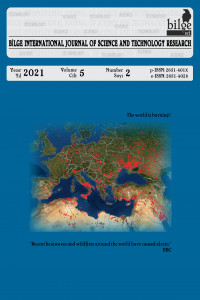Öz
The energy demand is increasing day by day. Therefore, the renewable and sustainable energy of geothermal power plants is very important. The biggest problems seen in geothermal power plants are sedimentation and scaling. The scaling occurs into the wells, pipelines and heat exchangers, etc. where the geothermal brine passes. Those locations where the elements and compounds in the geothermal brine precipitate under specific conditions, forms scales.
Those scales caused decreased efficiency of energy production. During the process of energy production, the temperature drops inside heat exchangers and that causes the antimony (Sb) compounds got precipitated and caused scaling. Those scales negatively affect heat transfer and eventually cause less energy to be produced by causing blockage of the vaporizer, preheater, and filters. For this reason, stibnite scaling is a situation that should be taken into serious consideration. Until now, different methods have been developed against stibnite scalings.
As of 2020, HYDRODIS® GE has been developed by the Bozzettto group, which stops the precipitation and cuts the operating costs. In this way, the antimony compounds where possibly creates scales got prevented and returned in the geothermal brine to the reservoir via reinjection wells by letting production continue without any energy loss.
Anahtar Kelimeler
Kaynakça
- Brown, K. (2011). Antimony and Arsenic Sulfide Scaling in Geothermal Binary Plants. May, 25–27 Scanes, C. G. (1989). Notice concerning copyright restrictions. Growth, Development, and Aging, 53
jeotermal enerji santrallerinde antimon bileşiklerinin HYDRODIS® GE isimli ürünler ile oluşumunun engellenmesi
Öz
Her geçen gün enerji ihtiyacı artmaktadır. Bu nedenle, Jeotermal enerji antrallerin yenilebilir ve sürdürülebilir olması çok önemlidir. Jeotermal enerji santrallerinde görülen en büyük problem çökelme ve kabuk oluşumlarıdır. Kabuk oluşumları, kuyuda, yüzey hatlarında, ısı değiştiricilerde vb. jeotermal akışkanın geçtiği her yerde oluşabilir. Bu bölgelerde, jeotermal akışkan içindeki elementler ve bileşikler özel koşullar altında çöker ve kabuk oluşturur. Oluşan bu kabuklar sebebiyle enerji üretiminin verimliliği düşer. Enerji üretim esnasında, ısı değiştiricilerin içinde sıcaklık düşer bu sebeple antimon (Sb) bileşikleri çökelir ve kabuk oluşmasına sebep olur. Bu kabuklar ısı transferini olumsuz yönde etkiler ve sonuç olarak buharlaştırıcı (vaporizer), ön ısıtıcı (preheater) ve santral çıkış filtrelerinde tıkanmasına bağlı olarak enerji üretimini düşürür. Bu sebeple, stibnit bileşiklerinin kabuklaşması, üzerinde ciddi durulması gereken bir durumdur. Günümüze kadar stibnit kabuğuna karşı farklı yöntemler denenmiştir. Hydrodis GE, 2020 itibari ile Bozzetto Group tarafından geliştirilmiş olup, stibnit çökelmelerini engellemesi ve işletme maliyetlerini düşürmesi amacıyla formüle edilmiştir. Böylece, antimon bileşiklerinin kabuk oluşturması engellenmiş olup, jeotermal akışkan içinde kalarak re-enjeksiyon kuyularına ve ordan da rezervuara her harhangibir enerji kaybı olmadan üretimin devam etmesini sağlar.
Anahtar Kelimeler
Kaynakça
- Brown, K. (2011). Antimony and Arsenic Sulfide Scaling in Geothermal Binary Plants. May, 25–27 Scanes, C. G. (1989). Notice concerning copyright restrictions. Growth, Development, and Aging, 53
Ayrıntılar
| Birincil Dil | İngilizce |
|---|---|
| Konular | Kimya Mühendisliği |
| Bölüm | Araştırma Makaleleri |
| Yazarlar | |
| Yayımlanma Tarihi | 30 Eylül 2021 |
| Kabul Tarihi | 24 Eylül 2021 |
| Yayımlandığı Sayı | Yıl 2021 Cilt: 5 Sayı: 2 |



